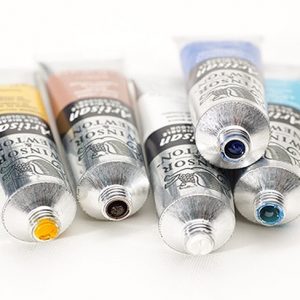Table of Contents
Toggle(Get free painting tips and plein air painting techniques sent straight to your inbox or on my social media.)
What medium do I use with water soluble oil paints?
You can mix them with water, linseed oil, stand oil, or other solvents. With each, you can get different effects. You can also use fast-drying mediums, impasto and alkyd mediums, as well as use blenders to give heavily pigmented colors a more transparent look.
Traditional linseed oil used to thin water soluble oils will give the painting a nice sheen and add depth to the color. There are specially formulated linseed, safflower, and other oils that have been designed to work with water-soluble oils.
FAQ
-
What Are Water Soluble Oil Paints?

Water soluble oil paints, or water mixable oil paints, are the same as real oil paints with the difference that they can be mixed and cleaned with water. They are also known as water miscible or solvent-free oils. Note that they are not water-based like acrylic and watercolors, but water soluble oil paints contain real oils. The difference from regular oil paint is that water soluble oil paints have been designed to accept water and get around the normal chemical barrier that prevents water and oils mixing. As with other oils, it is very easy to get rich, opaque layers of paint on canvas or board with water soluble oil paints. Creating texture and accenting your brush strokes for effect is also quite easy and similar to traditional oils.
-
Why should I use water soluble oil paints?
There are three main reasons why you may want to use water soluble oil paints:
1. If you like the versatility and vibrant colors you can get with oils but do not like working with solvents for health reasons, then water soluble oil paints are a healthy alternative since you do not need any solvents.
2. If you are working with acrylics but want the beautiful color depth and versatility of traditional oils, then water soluble oil paints will allow you to continue to work with water as you did with acrylics.
3. If you want an easier clean up system than when working with regular oils, then switch to water soluble oil paints.
Many artists enjoy the speed that comes from working with water soluble oil paints. These paints dry considerably faster than traditional oils, though not as fast as acrylics. Depending on how thick you paint, you may get up to 48 hours of workable time with water soluble oil paints before they loose their elasticity. -
What are the differences between water soluble oil paints and traditional oils?
Water soluble oil paints have a faster drying time compared with oils.
You can mix water soluble oil paints with water and so do not need any solvents.
Some pigments are more transparent than they are with their oil-based counterparts. Some artists have noticed this difference with the colors viridian green and cobalt blue.
The one aspect you may enjoy even more with water soluble oil paints is the ease of creating transparent glazes and water-washed underpaintings. This is where the ability to mix the pigment with water is very helpful.
If you use water on its own, it will often create a duller color and make the paint stickier. It doesn’t brush easily or work well when other oils are added.
How do you clean up water soluble oil paints?
Just use water to clean up with water soluble oil paints. This is one of the main advantages. You can use soapy water to clean your brushes. For paint that has partially dried, try to loosen it up by rubbing the bristles with a bit of oil. Your cleaning time is cut in half, you can breathe easily through the process, and you will not be left with colored hands, brushes, and clothes.
Use linseed oil for reviving dried water soluble oil paints on your palette.
Can I mix water soluble oil paints with other paints?
You can mix water soluble oil paints with traditional oils. If you do that though, you will lose some of the ability to mix the paint with water. Some people suggest a small amount of oil (below 25%) is a good range if you want to retain some water solubility. An oil-based solvent such as linseed oil will probably give you a better result.
You can use also use some acrylic paints to mix with your water soluble oil paints. Check with the acrylic paint manufacturer to ensure that it is in fact mixable with water soluble oil paints. It is not possible to use just any acrylic with this type of paint, so be sure to research the brands you intend to use. With acrylics, 25% or below is also a recommended amount for the mix.
About the drying time
- Allow plenty of drying time — a week to a few months depending on thickness and the solvent used — and avoid humid areas.
- To speed up drying time, add a fast-drying medium to your paint.
- If you used water, a shorter drying time is required because water evaporates more quickly than do oil-based solvents.
- Varnish finished paintings as you would any other oil. Before you varnish, make sure the painting is completely dry, not just dry to the touch.
Thank You
Thank you for taking the time to read this article. I hope you find it useful. If you would like to get free painting tips by email, please sign up for my free tips newsletter.
If you are interested in a structured approach for learning how to paint, take a look at my online painting classes.
Happy painting!
Barry John Raybould
Virtual Art Academy
What The Students Are Saying
comprehensive art education

The course is for beginners, intermediate and advanced artists

Read more “The course is for beginners, intermediate and advanced artists”
The sky’s the limit

The improvement in my own work reaffirms that I’ve found the right program to develop as an artist

‘Ladder of Learning’ adds to overall positive experience of this awesome course

Read more “‘Ladder of Learning’ adds to overall positive experience of this awesome course”
An excellent foundation on so many aspects of painting

When I got word of the course available through Virtual Art Academy, I was very excited for the opportunity to learn what I never knew about painting. VAA has provided me an excellent foundation on so many aspects of painting. The course is organized very logically, provides great examples, diagrams, thorough explanations and worthwhile assignments. I highly recommend this course to anyone with a desire for an in-depth education of art.
Thank you again, Barry, I love this course Jeanne
Read more “An excellent foundation on so many aspects of painting”
It is impossible to fail or gain little through extensive 4 year study at VAA!

Read more “It is impossible to fail or gain little through extensive 4 year study at VAA!”
The most comprehensive art instruction I could find anywhere online, and trust me, I had been looking for a long time.

The Virtual Art Academy is simply the most comprehensive art instruction I could find anywhere online, and trust me, I had been looking for a long time.
Even art schools and academies I’ve been exposed to are nowhere near as thorough, VAA is just amazing!
Most paintings I see where the artist clearly has some skill still lack in either the values or notan department, or fall down on composition – it’s baffling that VAA seems to be the only program that goes into detail on this. Therefore, if you are new to painting or an experienced artist, studying with VAA will get you to that next step.
I also find that Barry is always interested in what we students do and is at hand with great advice. Worth every penny, Thank you Barry!!
I started learning oil painting with VAA from scratch. Just one year later my paintings started to sell

It is a real course that trains you in a structured way

Read more “It is a real course that trains you in a structured way”
Building blocks of learning is the best I have seen

Read more “Building blocks of learning is the best I have seen”
Barry gave me a fishing rod so I can catch my own fish

Read more “Barry gave me a fishing rod so I can catch my own fish”
A great learning platform

The most comprehensive, in depth and well-organized painting course available online

Read more “The most comprehensive, in depth and well-organized painting course available online”
No need to buy expensive art books…. Just do the VAA 4 year course. I still refer to it

Read more “No need to buy expensive art books…. Just do the VAA 4 year course. I still refer to it”
It is wild to see how much I am learning in this course!

I retired last year, and decided I wanted to spend my time in retirement learning how to oil paint. But having never painted before, I wasn’t even sure what to look for in an online painting course. However, I did some searches for “Best Online Oil Painting Courses,” and found several references to VAA.
I signed up for VAA’s ongoing Apprentice Program last October (2023), and I am incredibly glad I did! As a beginner, I didn’t know what I didn’t know, but I didn’t have to: VAA has already mapped it all out for me. It starts out with basic, fundamental stuff, but also teaches me the THINKING that goes in the painting: the composition, my color choices, how to consciously select which darks and lights need to be emphasized, etc.
Bottomline, I am learning how to create paintings that have both visual music and poetry, and it is super fun to see my growth! I cannot recommend this course enough!
Read more “It is wild to see how much I am learning in this course!”
I’m Richard Robinson …. best online art training available on the internet today

In my opinion Barry has created the best online art training available. I found the Virtual Art Academy course of painting lessons many years ago and was so inspired by it that I contacted the author and got to know him personally.
Two Critical Keys
If you are looking (like I did) for the best painting course available there are two key things you should know about the Virtual Art Academy course which make it stand out above the other online painting courses available today:
1. It’s Comprehensive.
It covers ALL the key painting concepts and then goes further, revealing more and more painting insights. Most courses miss a LOT out – this one doesn’t.
2. It’s easy to understand.
All that information could easily become confusing, but each piece is laid out clearly and concisely using Information Mapping® making it a pleasure to learn.
If you can find another painting course which does these 2 things better, please let me know. As I said, I have been searching for many years and continue to do so, so you could save yourself a lot of precious time and money by joining the Virtual Art Academy today.
Read more “I’m Richard Robinson …. best online art training available on the internet today”
VAA, the ultimate art course

First quality education, materials, layered learning systems, feedback loop and social support and lifelong learning – amazing
Thank you again for such an amazing program and opportunity. I wish you continued and even greater success. You have contributed to many many people… thank you from all of us.
Since I started the programme I can see improvements in my composition and use of colour

I have been working through the VAA course for over five years and would highly recommend it to anyone wanting to improve their painting. There is a huge amount of information on the site and it is well presented and regularly updated and added to. When other members have commented on work I have posted I have found it really useful. When I review my work over the time since I started the programme I can see improvements in my composition and use of colour.
Read more “Since I started the programme I can see improvements in my composition and use of colour”
Fantastic lesson plans, and a vibrant community
The Virtual Art Academy is the perfect art course I’ve been searching for. Barry’s decades of knowledge are condensed into fantastic lesson plans, creating a vibrant community. The apprentice course delves deep into drawing, painting planning, and color theory. It’s like obtaining an art degree at my own pace and more affordably. The structured format encourages interaction and feedback, enhancing the learning experience. Overall, a fulfilling way to study art from home.
The equivalent of a 4 year art education at a fraction of the cost

Read more “The equivalent of a 4 year art education at a fraction of the cost”
Only online learning program I have ever discovered using a training industry best practice

VAA is the only online learning program I have ever discovered using a training industry best practice of incorporating Knowledge and Skills to support learning a new activity. Every building block (Drawing, Form, Observation, Concept, Notan, Composition, Colour, Brushwork) incorporates a “spiral learning” approach where you are introduced to the Knowledge/Skill at one level and then reintroduced to it again elsewhere in the curriculum. Sure genius.
I’ve attended workshops, read books, and watched YouTube videos — and none of them provide the scaffolded approach to learning the VAA offers. If you are just starting your painting journey, start here. If you are a mid level or advanced painter, start here. There is a sense of community with artists around the globe. You are part of a peer to peer learning process bigger than yourself.
As a result of the VAA, I have been juried into several shows, am represented by a local gallery and have been selling my paintings on a consistent basis. VAA curriculum’s approach will grow your ‘artist’s brush’ and aid you in finding your artistic voice. As your basics improve, your art improves. Henry Hensche said, “There is study and there is performance, and we should not confuse the two, study is done for perceptual development, our performances show us where we are in that development, and we must have both…”. VAA curriculum offers both.
I went through the entire curriculum, did every every exercise, and today review my printed books/exercises on an annual basis to keep myself fresh and ready for my next painting adventure.
Onwards/Sideways,
Jay “jbird” Holobach
https://www.jayholobach.com/
The course has a steady learning curve that keeps revealing itself as you advance

Read more “The course has a steady learning curve that keeps revealing itself as you advance”
This is a far more superior school than anything I have seen being taught at colleges across the country

The small steps are easy to do
